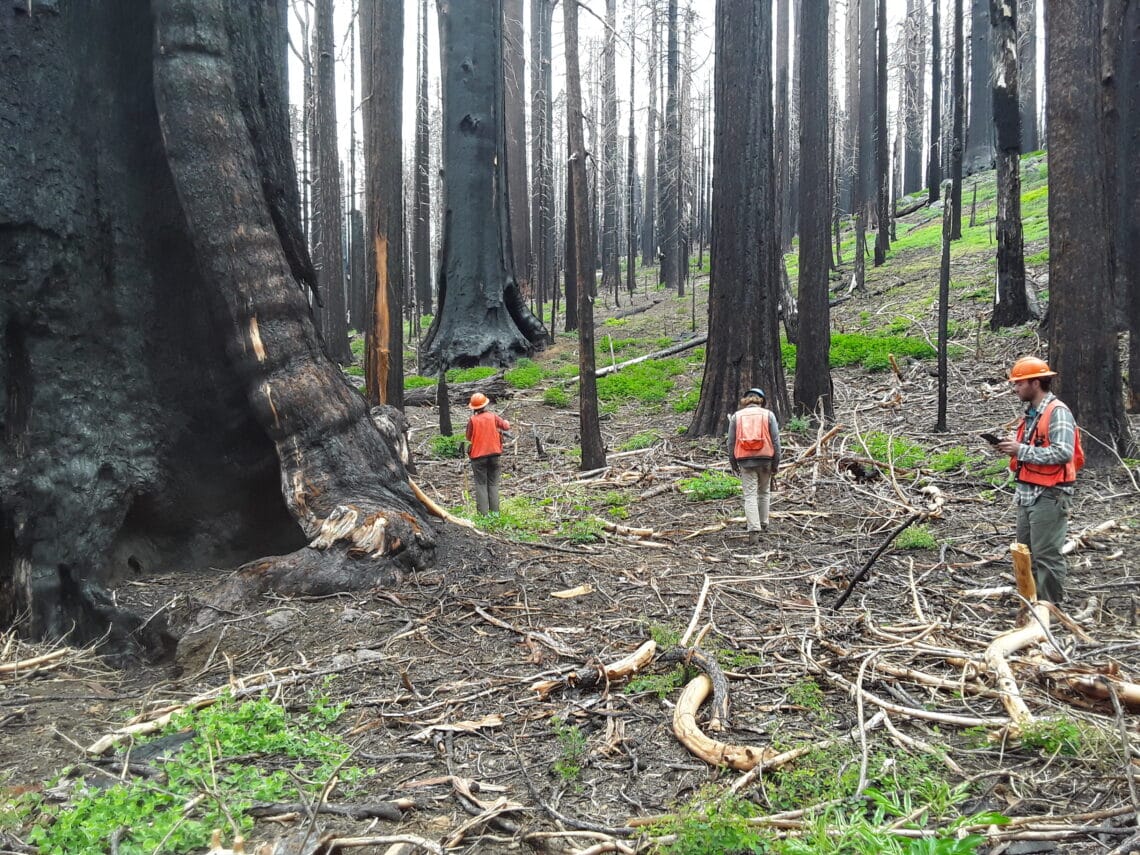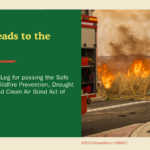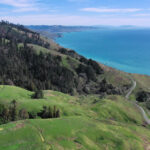
Robin Carr, Landis Communications Inc.
Email: Redwoods@LandisPR.com | Phone: (415) 766-0927
Download the full press release
Two publications discuss the substantial risk of losing portions of sequoia groves due to high tree mortality rates and inadequate natural recovery
Restoration actions are needed to prevent further loss

Tulare County, Calif. (July 15, 2024) – In two comprehensive giant sequoia regeneration studies, announced today by the Giant Sequoia Lands Coalition, researchers with the U.S. Geological Survey’s Western Ecological Research Center found that some areas affected by recent mega-fires may not have enough seedlings to grow the next generation of millennia-aged trees. Extreme wildfires have killed up to 20% of the world’s mature giant sequoias since 2015, a majority of which perished from three wildfires in 2020 and 2021.
The recent mega-fires burned at a size and severity far more extreme than the historic norm, and the new studies show that without intervention, some giant sequoia groves may experience a long-term or permanent loss of acreage as seed trees have died, and the number of new seedlings is exceptionally low.
“What we used to call high-severity fire does not compare to the unprecedented scale and severity of the wildfires we’ve experienced in recent years in the Sierra Nevada,” said one of the paper’s lead authors, Nathan Stephenson, Ph.D., scientist emeritus at the U.S. Geological Survey’s Western Ecological Research Center and one of the foremost experts on sequoias. “Giant sequoias are the largest trees in the world. They’re fire-adapted and rely on fire to reproduce. But recent fires have killed thousands of mature trees and, in some cases, their seeds too.” The U.S. Geological Survey has provided scientific expertise and data-driven models to the Giant Sequoia Lands Coalition to inform land management and restoration decisions.
Researchers also noted that the seedlings that germinated after the 2020 and 2021 wildfires are growing under new climate conditions, including higher average temperatures and the most severe drought conditions of the 121-year historical record. These conditions will almost certainly reduce the survival of giant sequoia seedlings. In areas where the mature seed trees have died, chances of natural recovery will almost certainly be greatly diminished.
“Sequoia regeneration has varied widely across the range since the recent mega-fires,” said lead author David Soderberg, Ph.D., ecologist at the U.S. Geological Survey’s Western Ecological Research Center. “Some areas are doing well, but in other sites where the seeds and seed trees burned, or where young seedlings have died from high heat and drought, natural long-term recovery appears to be unlikely. Our data suggest that sequoia grove areas that were severely impacted by the fires may not have enough reproduction to replace the sequoias lost.”
Giant sequoias are the world’s largest trees and among the oldest. As climate allies, the old-growth sequoia groves are second only to old-growth coast redwood forests in storing massive amounts of carbon per area. They capture the imagination of people who come from all over the world to visit the protected groves.

Scientific research guides restoration work on the ground
“These are important findings that identify the density of seedlings—the number per area—that is enough for the tiny, young trees to survive and become majestic sequoia adults,” said Joanna Nelson, Ph.D., director of science and conservation planning for Save the Redwoods League and a lead scientist with the Giant Sequoia Lands Coalition.
Nelson says this new research could help land managers determine how to best care for the giant sequoia groves, especially in emergency-response windows post fire. “Working from the best science available, we can better understand when and where sequoia reproduction may be too low for future success—and be equipped to take action. At the same time, we continue to prioritize fuels reduction treatments that favorably change fire behavior and reduce the severity of potential future wildfires.”
Ongoing research and monitoring are supported by the Giant Sequoia Lands Coalition to continue providing a scientific basis for restoration programs across the sequoia range. To date, GSLC has completed wildfire resilience work across half of California’s giant sequoia acres; planted more than 500,000 native seedlings in severely burned areas where reproduction has been insufficient; and conducted scientific research to support evidence-based restoration techniques. Read more in the GSLC’s recently published Progress Report for Saving the Sequoias.
About the new research:
- Post-fire reference densities for giant sequoia seedlings in a new era of high-severity wildfires, published in the June 2024 issue of Forest Ecology and Management.
Dr. Stephenson and co-authors developed conservative estimates of the natural amount of sequoia seedlings per area that would be considered adequate for forest regeneration and the number of seedlings per area that would be needed to expect sufficient tree survival to adulthood. Study data will serve as a reference that land managers can use to interpret the effects of wildfires on sequoia reproduction and assess, on a case-by-case basis, whether they need to replant sequoias to maintain current populations and groves.
Consistent with past studies, this research also documented an initial post-fire burst of giant sequoia seedlings followed by a significant decline due to high seedling mortality rates, low subsequent germination and low establishment of new seedlings in subsequent years. For giant sequoias, seedling establishment is generally limited to the first two summers following a fire. The results are based on post-fire records from Sequoia & Kings Canyon National Parks, spanning 48 years (1969–2016) in 42 sites in eight giant sequoia groves that burned in 26 different fires. The authors then quantified the difference between the climate that prevailed between 1969 and2016 and the climate that prevailed after the 2020 and 2021 wildfires.
- Assessing giant sequoia mortality and regeneration following high-severity wildfire, published in the March 2024 issue of Ecosphere.
This study assessed the likelihood of natural recovery of giant sequoias in areas affected by the 2020 and 2021 mega-fires. Dr. Soderberg and co-authors reviewed evidence that recent wildfire severity in the Sierra Nevada has been far more extreme than the historic norm and that if no interventions are taken, we might see a long-term or permanent loss of sequoia grove area. This is especially true in areas where mature seed trees were killed, where cones were burned out of the trees’ crowns and where the amounts of new seedlings are well below historic norms in the years since the wildfires. The results of this study are based on extensive surveys of four groves in Sequoia & Kings Canyon National Parks that were severely impacted by the 2020 SQF Complex Fire and 2021 KNP Complex Fire.
To provide conservative comparisons of the effects of the recent mega-fires to historically normal fire effects, the researchers contrasted second-year reference densities presented in the Stephenson et al. paper described above with giant sequoia seedling densities in the four groves that burned in 2020 and 2021. They found that in some areas, seedling amounts were well below historic norms and could not be expected to maintain or recover the groves to their pre-fire structure. Seedling density also depended on the proximity to nearby sequoia crowns that were either alive and green or scorched (brown from fire’s heat) but not torched (blackened and consumed by fire).
The study also provides a statistical tool to inform restoration and management decisions following large, severe wildfires in the timeframe when managers need answers and to make management decisions following wildfires.
###
About Giant Sequoia Lands Coalition
The Giant Sequoia Lands Coalition (GSLC) is a landscape-scale, multi-partner collaboration dedicated to the conservation and stewardship of giant sequoia grove ecosystems. Our coalition is composed of all federal, tribal, state, and local agencies and organizations that manage giant sequoia groves in public, tribal, or private nonprofit ownership. Our affiliate partners include federal and state conservation agencies, non-governmental organization conservation groups, and academic research partners with a shared commitment to protect and steward giant sequoias and their ecosystems from emerging threats associated with climate change and the extended absence of natural wildfire processes on the landscape. For more information, visit giantsequoias.org.
— Note to media: Images of GSLC projects and places are available for download here. —

About Giant Sequoia Lands Coalition
The Giant Sequoia Lands Coalition (GSLC) is a landscape-scale, multi-partner collaboration dedicated to the conservation and stewardship of giant sequoia grove ecosystems. Our coalition is composed of all federal, tribal, state, and local agencies and organizations that manage giant sequoia groves in public, tribal, or private nonprofit ownership. Our affiliate partners include federal and state conservation agencies, non-governmental organization conservation groups, and academic research partners with a shared commitment to protect and steward giant sequoias and their ecosystems from emerging threats associated with climate change and the extended absence of natural wildfire processes on the landscape. For more information, visit giantsequoias.org.
Tags: 2024, giant sequoia, giant sequoia lands coalition, Press Release

